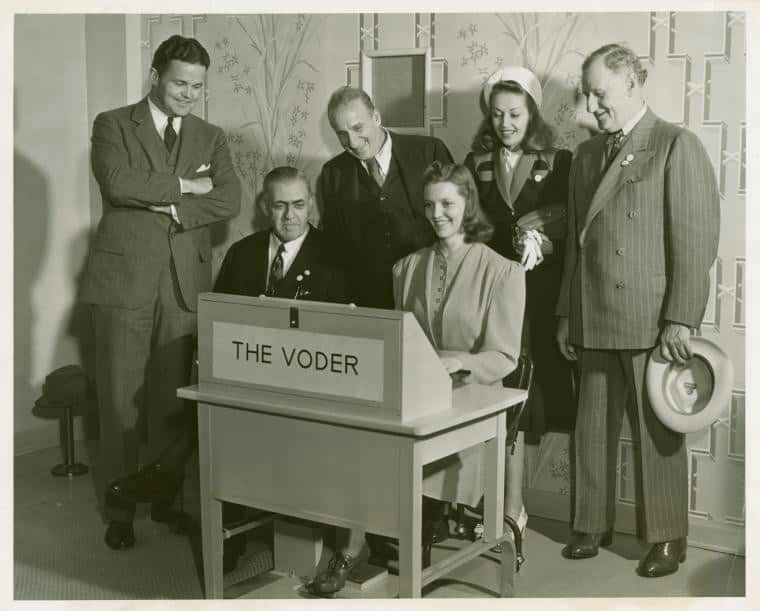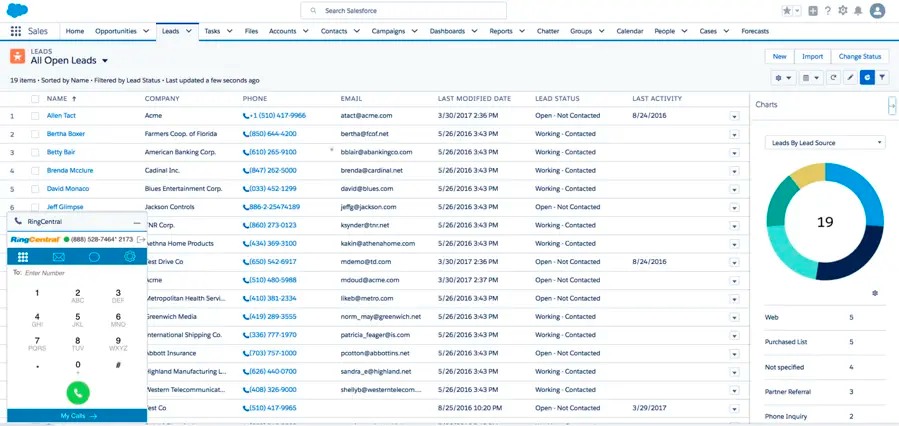Interactive voice response (IVR) is an automated business phone system that answers incoming calls and offers options and information via a menu. The history of IVR began in the 1930s with Bell Lab’s invention of the Voder machine. Since then, IVR technology has improved—from early systems using touch-tone keypads to advanced speech processing. IVR solutions have evolved into conversational platforms delivering intuitive client experiences.
This article discusses IVR history, its advancement and evolution throughout the years, its overall impact on the customer journey, and what’s next for this technology.
IVR’s history began with the invention of the Voder machine in the 1930s.
What to know more about IVR? Read our “What is IVR?” article and learn more about how it can improve your customer service efforts.
1930s: Successful Synthesis of the Human Voice
The Voder machine, created by Homer Dudley of Bell Laboratories, was the first electronic machine to produce synthetic human speech. This technology, derived from the phrase “voice operation demonstrator,” converts buzzing tones from their relaxation oscillator into vowel and nasal sounds. It also features additional special keys to generate complex consonant sounds. This attempt synthesized human speech by breaking sounds down into acoustic components.

The Voder can be operated through keys and pedals to produce human-like audio.
(Source: Wonderful Engineering)
The machine is handled by a trained operator who manually controls speech tones using 14 keys with fingers, a bar handled by the left wrist, and a foot pedal. While the speech quality produced by the Voder machine left a lot to be desired, its invention holds historical significance. Since the successful synthesis of the human voice, the technology has evolved and found unlimited applications in today’s communication scenarios, including contact centers.
1960s: Large-scale Telephony & Digital Touch-tone Technology
Following the development of the Voder machine, by the 1960s, Bell Labs was exploring multi-frequency techniques and strategies to make calling more efficient. As call centers gained prominence, the challenge was finding cost-efficient alternatives to hiring thousands of call routers, essential to traditional private branch exchange (PBX) technology.
The first telephone keypads consisted of a four-column layout with letters A to D.
During this time, the DTMF (dual-tone multi-frequency), a signaling system that enabled touch-tone dialing and the emergence of phones with keypads, was created. The four-column DTMF keypad layout consists of letters “A,” “B,” “C,” and “D,” with numbers “0” to “9,” and “*” and “#” keys. This touch-tone system eventually replaced the rotary dial, and a simple IVR solution developed as touch-tone dialing became readily available to consumers.
1970s: Increased Use of Expensive IVRs
The touch-tone system and synthetic speech allowed the first IVR solution to emerge in the 1970s. The first commercial use of IVR was in 1973 when Steven Schmidt used the technology for an order inventory control system. IVRs were also used by banks when tellers needed to verify customer balances. This integration improved consumer interactions, even though its vocabulary was still flawed.
When it comes to IVR history, the technology’s use increased during the ’70s, even though it was still too expensive for call center automation.
1980s: Computer Science & Hardware Developments
The 1980s marked a boom in call center technology, leading to an increased need for IVRs. Leon Ferber released Perception Technology during this decade, which became the first mainstream hard drive market competitor. This meant people could cost-effectively store digitized speech, play audio messages back, and understand and process DTMF responses. With hardware developments, IVR technology has become more affordable for companies.
These advancements led to coordinating and integrating computer and telephone data on an IVR system. Another significant leap was the origination of computer telephony integration (CTI) as the IVR evolution continued. Other technological innovations during this period include speech-enabled IVRs and some of the earliest successes in machine learning (ML) and artificial intelligence (AI).
1990s & 2000s: IVRs With CTI Became Vital for Call Centers
The 1990s, well into the 2000s, saw IVRs become widely used and by the mid-1990s, call queuing and automatic call routing became common in business. Toward the end of the decade, multimedia migration to call centers led to companies investing in IVR systems with CTI. This allowed businesses to integrate their call centers into their marketing campaigns. Also, with continued technology developments, IVRs became cheaper for company implementation.
As a result of the progressive history of IVR, by the 1990s, IVRs were essential to call centers, and automatic call routing and queuing became standard practice. As software companies invested in IVR advancements in the 2000s, speech recognition software developed and eventually became more affordable, allowing faster processing speed.
2010s: Advanced Call Management
By 2010, all-inclusive platforms emerged featuring advanced call tracking functions, automatic short message service (SMS), and comprehensive analytics features. This is when the advanced IVR systems we know today began to take shape. Advancements allowed customers to contact companies using various channels, allowing clients to choose their communication method.
RingCentral is a leading business phone system provider offering multi-level IVR features in its base plan. It provides a comprehensive set of calling features that support your IVR system, including real-time dashboards, voicemail, and robust integrations. RingCentral offers omnichannel communication options, allowing you to support customers through their preferred medium.

RingCentral’s multi-level IVR allows users to set up account-wide call routing rules across multiple locations. (Source: RingCentral)
2020s to Present Day: Modern IVR Systems
Present-day IVR systems prioritize efficient operations and the customer experience. Custom IVR solutions allow companies to design a system that resonates with their clients and carries branding elements, such as voice, tone, and music. In addition to advanced call management services, IVR systems have data protection and spam detection features.
Nextiva is a cloud-based voice-over-internet-protocol (VoIP) communications solution. It offers advanced IVR features, integrating speech recognition technologies for improved customer service and call routing. It also features a work hub consolidating communication channels into one platform for better internal collaboration.

Nextiva’s conversational AI supports open-ended prompts for automated routing. (Source: Nextiva)
Modern IVRs allow companies to integrate phone systems into marketing campaigns and provide fast solutions. They’re used in various industries and situations like hotel reservations, bill payment, and digital banking. This technology is part of most companies’ daily customer journeys and offers helpful information to people calling your business. Self-service IVR features are available, allowing customers to solve their concerns.
Tip: It’s best to keep options clear and concise when creating self-service menus. Avoid making callers repeat themselves and always provide an opportunity for speaking with an agent. Read our IVR design best practices and tips to optimize customer interactions and agent performance.
IVRs elevate the customer experience as agents are able to spend less time with tedious information-gathering tasks and focus more on giving excellent client service. With cloud-based IVR systems, companies can lower the cost per call, increase first-contact resolution, and enhance agent performance and business efficiency.
The Future of IVR
In the nearly 100-year history of IVR, the technology has come a long way and remains dynamic. We’re seeing more and more artificial intelligence (AI) applications being integrated into IVR systems. AI and machine learning (ML) technologies continue to improve conversational quality by enabling phone systems to converse logically and accurately.
AI-enabled IVR systems leverage Natural Language Processing (NLP) to respond efficiently to the natural flow of human conversations. Voice recognition technology already offers sentiment analysis and detection, and with constant technology growth, the possibilities are endless. We expect IVR technology to assist callers without the need for agents or perform seamless transitions between IVR systems and agents.
With improvements in automation, we may soon see the integration of call routing and multimedia content like videos. IVR systems will likely see greater support and compatibility between phone systems and digital assistants, such as Siri and Alexa. IVRs have become a crucial element of customer service, and as it continues to present unique opportunities for communication, IVRs are likely here to stay.
In order for your IVR system to be successful, it’s important to keep in mind that the design should cater to the caller, not to the company. For more information on designing the right system, read our step-by-step guide to setting up an IVR system.
Best IVR Solutions
Based on this IVR history and breakdown of technology milestones, IVR solutions offer financial and operational benefits that small businesses can take advantage of. Consider a VoIP phone system provider offering robust IVR services. Not all providers offer IVR in their base plans, so check the inclusions of your chosen plans. Below are some VoIP providers with IVR solutions:
Best IVR Providers | Monthly Starting Price (per User) | Key Features | Free Trial | Learn More |
|---|---|---|---|---|
$30 |
| 14 days | ||
$30.95 |
| 7 days | ||
$1 per hour for active users |
| 30 days | ||
Frequently Asked Questions (FAQs)
Poorly implemented IVR systems can damage a business’ reputation and frustrate customers, affecting client sentiment and loyalty. While IVRs are cost-effective and time-saving, not all customers are comfortable speaking with an automated system, especially when frustrated. Minimize this by keeping your menu simple and always providing a live agent option.
Automated attendants serve a specific and simple purpose of replacing live operators. It can provide information through prerecorded messages and route calls based on menu options. On the other hand, IVRs are able to serve more specific functions through caller interaction, like facilitating account inquiries and telephone banking. IVRs allow customers to interact with a company using their voice.
The two types of IVR services are inbound and outbound. Inbound IVR systems are software that handles incoming calls, while outbound IVR systems make calls using partial or fully automated dialing. Providers often offer both options, but opting for inbound-only IVR is more affordable.
Bottom Line
Our history of IVR summary found that one of the most significant milestones in IVR’s development is its evolution from a call routing tool to a customer service strategy. This cemented the importance of IVR as an essential technology for businesses worldwide. Small businesses benefit from improved business effectiveness and increased customer confidence.
With a better understanding of the history of IVR, consider RingCentral, one of our recommended IVR services for small businesses. Take advantage of its 14-day free trial today.